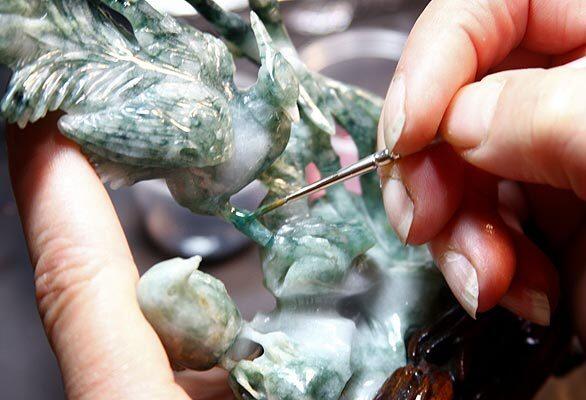
It’s fitting to find Polizzotto inhabiting a miniature world of her own. Her Topanga studio packs living quarters, office, work area, art gallery and library into a single room less than 20 feet square.
Cheese domes and fluted glass cake stands line her work area, offering protection during the hours a repair takes to harden. The minutest speck of dust will cause a smooth surface to bubble. Anything less than exact proportions when she mixes the two resins will result in a finish that remains soft and easily scarred. She clearly enjoys the need for precision, carefully weighing small amounts of one resin before adding the second, drop by drop.
Polizzotto stirs two clear substances together, then adds droplets of color to the resulting jelly-like mix. She likes to work with a four-power lens but switches to 10-power magnification for the most detailed repair. She applies color with a fine brush and stretches the mix carefully across a piece’s surface. What creates that controlled viscosity? Polizzotto smiles. That’s her secret. (Jake Danna Stevens / Los Angeles Times)

Jewelry, vases, vintage cosmetics compacts – anything of value, monetary or sentimental, comes into her studio for repair, sometimes from overseas. (Jake Danna Stevens / Los Angeles Times)

Polizzotto learned none of her enameling skills in her years at New York’s Art Student League and School of Visual Arts. Trained as a painter, she supported herself with jobs as seamstress, clothing designer, chef. At the suggestion of an antiques dealer she worked for, she began teaching herself about resins. She started her business in 1993, and the bulk of her clients were dealers. Lately her website, enamelrestoration.com, has attracted more retail customers, including one with a damaged clock face and a priest with a chalice needing repair. (Jake Danna Stevens / Los Angeles Times)
Advertisement

Because enamel’s depth and intensity of color rival those of precious stones, early artists borrowed jewelers’ techniques, creating patterns mosaic-fashion by setting sprinklings of powdered glass in separate cell-like pockets. In cloisonné enamel, thin wires separate the cells and form a fine tracery of lines on the finished surface. Polizzotto’s specialty is a related style, plique-a-jour. Originating in medieval France, it too traps enamel between a net of wires, but these have no metal backing. The effect is like that of a stained-glass window. (Jake Danna Stevens / Los Angeles Times)

Prices vary according to the time involved. The vase whose landscape she had to research and repaint will run around $250. A single guilloche compact costs $30 to $60. (Jake Danna Stevens / Los Angeles Times)

With her naturally steady hand, Polizzotto focuses on a piece of jewelry.
To see other installments in this ongoing series, The Fixers, go to www.latimes.com.fixers. (Jake Danna Stevens / Los Angeles Times)




